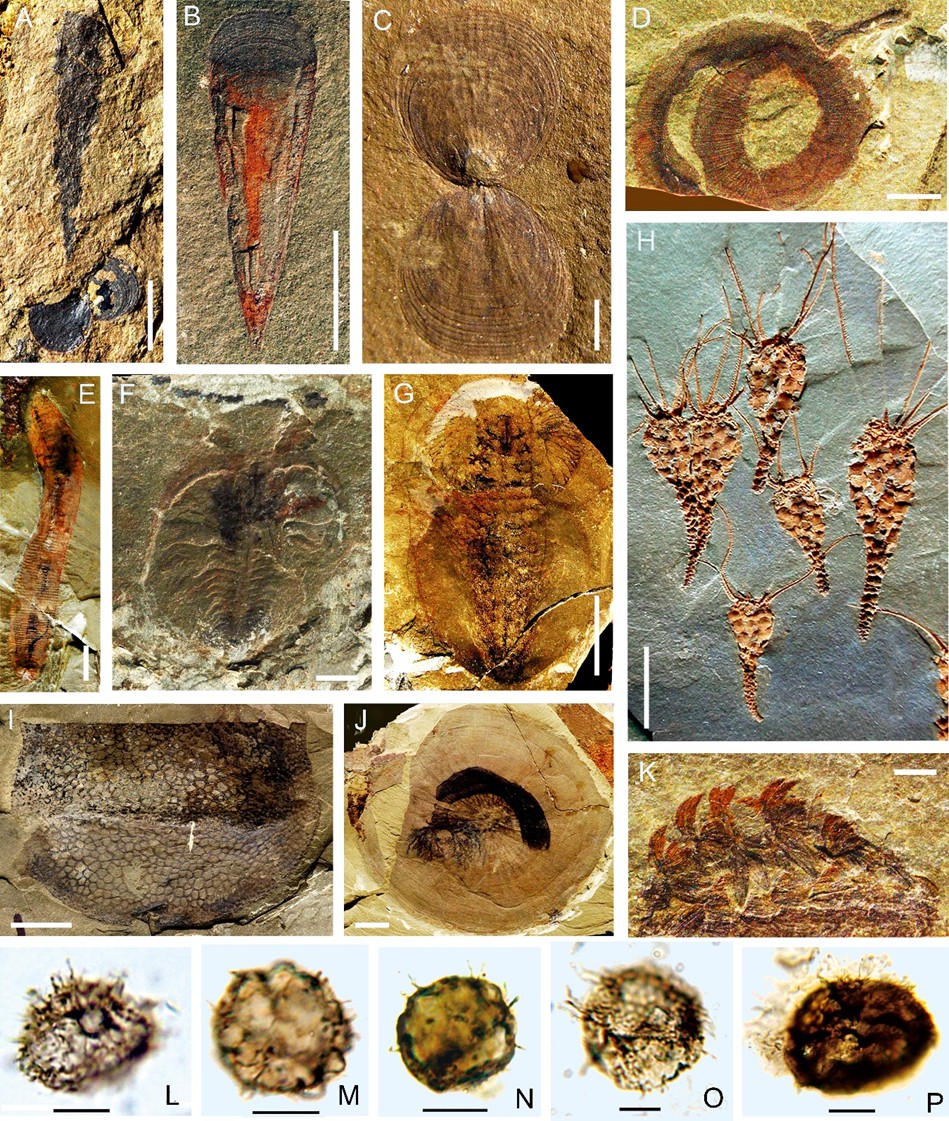Kaili Fm
Type Locality and Naming
The type section of Kaili Formation is located at Jiumenchong in Nangao Township, Danzhai County, Qiandongnan Miao-Dong Autonomous Prefecture, Guizhou Province (107°52’E, 26°23’N). The section was measured by the Guizhou Regional Geological Survey Team in 1961, and remeasured by Zhang Zhenghua, Zhou Zhiyi and others from the Institute of Geology, Guizhou Headquarter of Petroleum Exploration and the Nanjing Institute of Geology and Palaeontology, Chinese Academy of Sciences in 1970. In the type section the Kaili Formation is 277.5 m thick. The Kaili Formation was named by Lu (1963). The name is derived from Kaili City, Qiandongnan Miao-Dong Autonomous Prefecture, southeastern Guizhou Province.
Synonym:
Lithology and Thickness
The Kaili Formation is a clastic sequence with minor interbeds of carbonate rocks. In the type section the formation consists of yellowish green and greyish green, sandy and calcareous shale, mudstone, argillaceous siltstone, and grey thin- to medium-bedded limestone or marlstone. The limestone or marlstone occur mainly in the upper part.
Relationships and Distribution
Lower contact
The Kaili Fm is in conformable contact with the underlying Chinghsutung Fm. The lower boundary of the formation is defined by disappearance of limestone of Chinghsutung Fm.
Upper contact
The Kaili Fm is in conformable contact with the overlying Jialao Fm. The upper boundary is defined by the appearance of either the black carbonaceous limestone of Jialao Fm or the dolomite of Loushankuan Fm respectively.
Regional extent
The Kaili Formation is exposed in the Jiangnan Slope Area of South China Region, restricted to Danzhai, Jianhe, Kaili, and Taijiang counties and Tongren City of eastern Guizhou Province. The formation has maximum thickness of 320 m in the Nangao area, and deceases thickness northward with minimum thickness of 10 m at Huangjiayuan, Tongren City.
GeoJSON
Fossils
In the type section, the Kaili Formation yields trilobites Burlingia ovate, Danzhaiaspis quadratus, D. similis, Danzhainia conica, D. spinosa, Eoptychoparia nangaoensis, Kaotaia globosa, K. magna, Kootenia jialaoensis, Kunmingaspis qiannanensis, Metabalangia yupingensis, Mufushania nankingensis, Nangaoia megaceps, Nangaops danzhaiensis, N. elongatus, Onchocephalus?sanwanensis, Oryctocephaloides convexus, O. elongatus, O. nangaoensis, Oryctocephalus indicus, O. sp., Pachyaspis lilia, Pagetia danzhaiensis, P. sp., Peronopsis sp., Probowaniella lata, Xingrenaspis brevis, X. quadrata, X. xingrenensis, and X. sp. Yuan et al. (2002) described many trilobite genera (subgenera) and species from the Kaili Formation, of which the additional genera (subgenera) are: Arthricocephalites, Balangcunaspis, B. (Taijiangia), Barklyella, Bathynotus, Chittidilla, C. (Diandongaspidella), Curvoryctocephalus, Douposiella, Eodouposiella, Eosoptychoparia, Euarthricocephalus, Euarthricocephalus (Microryctocara), Gaotanaspis, Gedongaspis, Hemicricometopus, Kailiella, Kaotaia (Eokaotaia), Kermanella, Kuetsingocephalus, Majiangia, Metarthricocephalus, Nangaoia (Shilengshuia), Olenoides, Oryctocephalus, O. (Eoryctocephalus), Oryctocephalina, Oryctocephalites (O.), Oryctocephaloides, Oryctocephalops, Ovatoryctocara, Parachangaspis, Paragraulos, Paramgaspis, Parashuiyuella, Pianaspis (P.), Probowmania (Guwmnia), P. (Probowmania), Protoryctocephalus, Qiannanagraulos, Redlichia, Sanhuangshania, Sanwania, Schmalenseeia, Sinoschistometopus, Stoecklinia, Taijiangocephalus, Temnoura, and Yuehsienszella. The formation contains Kaili biota, which is dominated by trilobites and bears other fossil groups including brachiopods, bradoriid arthropods, echinoderms, priapulids (worms), hyoliths, large bivalved arthropods, macroscopic algae, and trace fossils.
[Figure 1: Trilobite index fossils of the Kaili Formation at Balang, Jianhe County, eastern Guizhou Province. A, Bathynotus kuichouensis Lu in Wang et al., 1964, exoskeleton, from the Bathynotus kuichouensis-Ovatoryctocara sinensis Assemblage-zone; B, Ovatoryctocara sinensis Zhao et al., 2015, exoskeleton, from the Bathynotus kuichouensis-Ovatoryctocara sinensis Assemblage-zone; C, D, Oryctocephalus indicus (Reed, 1910), exoskeletons, from the Oryctocephalus indicus Zone; E−G, Peronopsis taijiangensis Huang et Yuan, 1994, exoskeleton, cephalon and pygidium, from the Peronopsis taijiangensis Zone. Scale bars = 5 mm for A, 2 mm for B−D; 1 mm for E−G.]
[Figure 2: Non-trilobite taxa of the Kaili Biota from the Kaili Formation at Balang, Jianhe County, eastern Guizhou Province. A, Angulosuspongia sinensis Yang et al., 2017 attached to Glyptacrothele bohemica; B, Haplophrentis cf. H. carinatus Matthew, 1899; C, Acrothele sp.,; D, palaeoscolecid, gen. et sp.; E, Ottoia guizhouensis Yang et al., 2016; F, Marrella sp.; G, Naraoia cf. N. compacta Walcott, 1912; H, Sinoeocrinus lui Zhao et al, 1994a; I, Tuzoia bispinosa Yuan et Zhao, 1999; J, Pararotadiscus guizhouensis Zhao and Zhu, 1994; K, Wiwaxia taijiangensis Zhao et al., 1994b; L, Heliosphaeridium nodosum Moczydłowska, 1998; M, N, Globosphaeridium cerinum (Volkova) comb. Moczydłowska, 1991; O, Solisphaeridium flexipilosum (Slavicova) comb. Moczydłowska, 1998; E, Comasphaeridium molliculum Moczydłowska and Vidal, 1988. Scale bars = 5 mm for A, B, E, G, I; 10 mm for H, J; 2 mm for C, D, F, K; 10 µm for L−P]
Age
Depositional setting
The formation represents marginal slope deposits.
Additional Information

